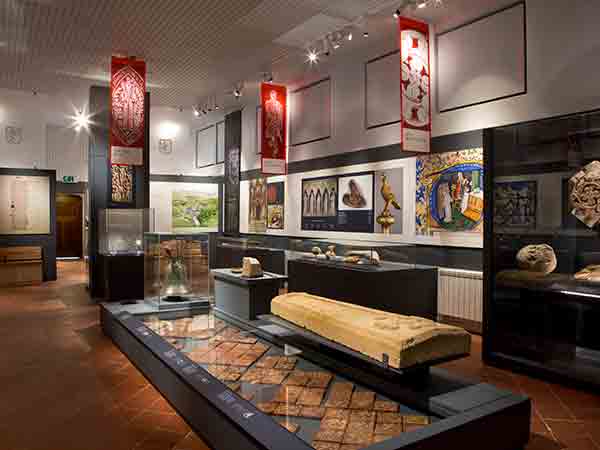New museum at Cotswold beauty spot reveals monastery’s hidden stories

English Heritage’s new museum telling the captivating and dramatic story of the Cotswold abbey that was once one of England’s most important pilgrim destinations opens on 30 June.
Hailes Abbey in Gloucestershire was founded by Earl Richard of Cornwall, son of King John and brother of Henry III, in the 1240s. For nearly 300 years, pilgrims from across England flocked to Hailes to visit a shrine said to contain blood shed by Christ on the cross, before the abbey dramatically suppressed by Henry VIII’s commissioners on Christmas Eve 1539.
The new museum provides fascinating new insights into the history of the abbey and the lives of the monks who worshipped and lived at Hailes for nearly three centuries, drawing pilgrims over long distances to visit the Blood of Hailes, a phial believed to contain blood shed by Christ on the Cross. Miracles were attributed to this holiest of a relic, which was mentioned in Geoffrey Chaucer’s Canterbury Tales, but it was later denounced as a fake during Henry VIII’s Reformation and its shrine destroyed. The monks were cast out, and the church was rapidly reduced to ruins and then plundered by locals.
The new museum vividly brings to life 300 years of piety, culture and tradition at Hailes. Visitors will be greeted by an imposing 13th-century stone sculpture of Old Testament figure Sampson fighting a lion. Symbolising Christ’s defeat of death, the sculpture was once a boss in the ceiling in the abbey’s chapter house.
Among the other treasures inside the museum, visitors will find an exceptionally rare fragment of 14th-century monk’s spectacles, lost for centuries on the site of the monks’ choir-stalls. A new invention in the 14th century, it is easy to imagine the frustration of the monk who misplaced them. The museum also holds the metal seal of the abbey’s confraternity or brotherhood, depicting a monk holding the Holy Blood of Hailes. Membership enabled lay people to benefit from the prayers of the monks and included some of the richest and most powerful individuals in late medieval England.
Other highlights include:
- 13th-century floor tiles depicting the coats of arms of Earl Richard of Cornwall and other members of his family.
- Fragments of the funerary monuments of Earl Richard and other members of the English royal family buried here.
- Decorative stonework evoking the splendour of the abbey’s buildings
Dr Michael Carter, Senior Properties Historian for English Heritage, said: “Hailes Abbey was one of the last and greatest Cistercian abbeys to be founded in England. Thanks to the relic of the Holy Blood, the name of Hailes was familiar to popes and kings. Modern day visitors are following in the footsteps of the pilgrims who made long and arduous journeys to Hailes. Just like their medieval predecessors, they will be struck by the beauty of the abbey’s setting in the foothills of the Cotswolds.
“The new museum contains artefacts of international significance and provides fascinating new insights into the abbey’s royal founder, medieval belief and piety and the daily routine of the generations of Cistercian monks who lived here, their way of life brought to a sudden end by Henry VIII in 1539.”
The abbey was founded by the most powerful man in Europe, Richard, Earl of Cornwall in thanksgiving for surviving a storm at sea. The only Englishman to be crowned ‘King of the Romans’, Richard was later buried in the abbey church along with several members of his family. Their tombs were in the best of locations, close to the high altar in the hope this would hasten the passage of their souls to Heaven.
Following the Suppression, the abbot’s house survived and became the home of the aristocratic Tracy family, but by the early 18th century, the family had left and the house soon fell into disuse, leaving the beautiful ruins at the foot of the Cotswold escarpment enjoyed by visitors today. In the 1920s, the importance of the abbey was recognised by Sir James Fowler, who arranged for the first museum at the abbey to be created, and a station opened nearby to bring visitors to the site.
Coinciding with the reopening of the museum, earlier this month the Gloucestershire Warwickshire Steam Railway reopened the abbey’s station, Hayles Abbey Halt, which now allows members of the public to visit the site by heritage railway for the first time since 1960. Whilst the site is owned by the National Trust, it has been in the care of English Heritage and its predecessors since 1948, and English Heritage operates the site. The metal seal of the abbey’s confraternity has been kindly loaned by the National Trust to support the new museum.
To accompany the reopening, a new 48 page guidebook researched and written by historian Dr Michael Carter – an expert in Cistercian monasteries - has also been published by English Heritage Guidebooks (ISBN 978-1-91-090720-7), and will be on sale at the abbey.
The new museum at Hailes Abbey is open daily until 31 October.
Explore Gloucestershire
30 June 2017
For further information.
OTHER NEWS
